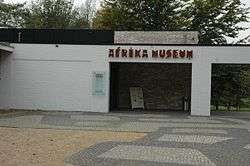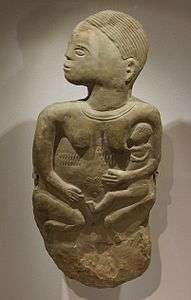Africa Museum
The Africa Museum (Dutch: Afrika Museum) is a museum in Berg en Dal in the Netherlands. The museum on the outskirts of the city of Nijmegen is a complex with indoor as well as open-air display areas, covering art, culture, music, photographs, videos and architecture of Africa.[3] As of 2014, the museum, along with the Tropenmuseum in Amsterdam, and National Museum of Ethnology (Museum Volkenkunde) in Leiden, together make up the National Museum of World Cultures.
Afrika Museum | |
 Museum entrance in 2007 | |
 Location within Gelderland | |
| Location | Postweg 6[1] Berg en Dal, Netherlands |
|---|---|
| Coordinates | 51°48′45″N 5°54′34″E |
| Type | Anthropological museum |
| Director | Stijn Schoonderwoerd[2] |
| Website | afrikamuseum |

Collection
Apart from displaying traditional historic sculptures, the museum focuses on exhibiting contemporary art produced in Africa and the diaspora such as North and South America and the Caribbean, especially on the islands of Cuba, Haiti and Curaçao. The section on religion and society displays artefacts regarding the cycle of life, healing, fighting off the evil. Outside, the visitors can experience rebuilt African architecture such as a Kusasi compound from Ghana, a Dogon clay building village from Mali and river-side pile dwellings from Benin.[4]
History
The museum was founded in 1954 as a missionary museum, five years after the Fathers of the Holy Spirit had acquired a property, which was to become a place of rest for the members of their congregation. With the museum they wanted to pay homage to the African cultures they had encountered and increase awareness of these cultures in Europe. While being stationed in Africa they had occasionally obtained objects for colonial exhibitions and collected objects that were both evidence of religious practices and of daily life and were sometimes destined for sale in the museum’s store.[5]
Father J.B. Van Croonenburg had a deep sensitivity to the artistic qualities of African sculpture and wanted to attract a broader public to understand the beauty and richness of African culture. Several priests admired the quality of these cultural objects that others qualified as “primitive”. Father Jan Vissers objected in the Cabinda area against the destruction of the traditional objects of the Woyo and collected a group of pottery lids with figural sculptures.[5]
In 1987 the museum opened its outdoor exhibition, which now consists of several reconstituted African villages.
Indoor exhibition
- Senufo sculpture, Ivory Coast
- Mau mask, Ivory Coast
- Ekpo mask
- Magbetu, Congo
 Mbamba grave stone, Angola
Mbamba grave stone, Angola- Wooden sculpture
Outdoor exhibition
- Dogon house
.jpg) Houses with murals
Houses with murals.jpg) Tower
Tower.jpg) African village
African village- Baka Pygmies village
References
- "Address en route Archived 2017-04-15 at the Wayback Machine", Afrika Museum. Retrieved 14 April 2017.
- "Wie zijn wij? Archived 2017-04-15 at the Wayback Machine" (in Dutch), Afrika Museum. Retrieved 14 April 2017.
- Vadi, Valentina; Schneider, Hildegard E.G.S., eds. (2014). Art, cultural heritage and the market : ethical and legal issues. Berlin, Heidelberg: Springer. p. 166. ISBN 9783642450945.
- Bal, Mieke; Janssen, Edwin (1996). Double exposures : the subject of cultural analysis. New York: Routledge. p. 195. ISBN 9780415917032.
- Tribal Art Magazine
External links
| Wikimedia Commons has media related to Africa Museum, Netherlands. |
- Official website (in English)